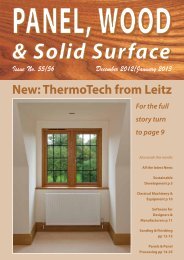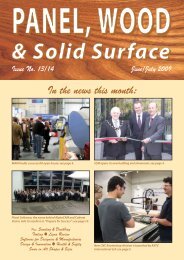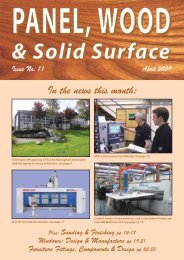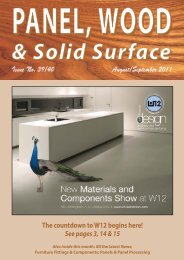December 2013/January 2014 - PAWPRINT PUBLISHING
December 2013/January 2014 - PAWPRINT PUBLISHING
December 2013/January 2014 - PAWPRINT PUBLISHING
Create successful ePaper yourself
Turn your PDF publications into a flip-book with our unique Google optimized e-Paper software.
SUSTAINABLE DEVELOPMENT<br />
carbon dioxide emissions?<br />
filtration of the emissions from the<br />
Nottingham Boots plant were required.<br />
The microalgae used at<br />
Nottingham Boots are strains of<br />
cyanobacteria which enjoy hot<br />
conditions, surviving at up to<br />
60° C, and the maximum temperature<br />
that the plant has reached is<br />
58° C. Furthermore, the cultures of<br />
these strains can be maintained<br />
for more than 18 months from a<br />
single inoculum.<br />
At present this technology is in<br />
the testing phase but, in the fullness<br />
of time, could it be applied to<br />
wood waste, allowing joinery<br />
workshops to enhance their green<br />
credentials while, at the same<br />
time, providing a possible revenue<br />
stream? One factor would be the<br />
emissions from such boilers.<br />
PW&SS contacted leading<br />
British manufacturer of wood<br />
waste burning systems, RanHeat<br />
Engineering Ltd, who in turn consulted<br />
their stack analyst, Tim<br />
Growcott of Halcyon Environmental.<br />
He writes: “In respect of emission<br />
profiles it is well established<br />
that wood burners typically emit<br />
20-250 mg/m 3 total particulate<br />
matter … the main component is<br />
usually CO 2, typically being 4-6%.<br />
“As a ‘secondary’ abatement option,<br />
algae suspensions could provide<br />
a viable option if the air<br />
stream temperature, sourced from<br />
the wood burner/boiler unit,<br />
could be reduced from typically<br />
100-250° C. Algae could certainly<br />
‘biophotocontact’ the available<br />
CO2 and CO [carbon monoxide]<br />
and might have capability with regard<br />
to the complex blends of organics<br />
(VOCs) produced during<br />
the wood burning process.<br />
“The issue for me is how the<br />
algae suspension would be ‘tailored’<br />
to deal with the air temperature<br />
and mass flow rates typically<br />
associated with wood burner<br />
units. … The algae suspension<br />
would also have to be ‘flexible’ to<br />
enable typical 5 days per week<br />
and eight hours per day production<br />
activities and seasonal variations,<br />
and also accommodate<br />
shut-downs and holiday periods.<br />
“The algae suspension plant<br />
would need to cope with typical<br />
discharge rates for pollutants and<br />
be capable of dealing with the extensive<br />
variety of wood sources<br />
likely to be encountered; as we<br />
have discovered wood sources<br />
can vary significantly in water content,<br />
oil components, particle size<br />
distributions and friability.<br />
“This is not to say that algae suspension<br />
is not an option.”<br />
Another EU-funded project,<br />
BioAlgaeSorb, has been investigating<br />
the possible use of wood<br />
burner flue gas (among others) as<br />
a source of nutrients for microalgae,<br />
and has such a system integrated<br />
into a microalgae reactor<br />
system at Swansea University. More<br />
on this will follow in a future issue.<br />
Algae have great potential: they<br />
can be a source of valuable products<br />
such as biofuels, fertilisers,<br />
cosmetics and pharmaceuticals.<br />
Conference delegates received<br />
pens made out of algae, with a<br />
more organic texture than pens<br />
made out of plastic, and very<br />
pleasant to hold. The UK is a world<br />
leader in the biological sciences.<br />
The Cambridge pilot facility<br />
(illustrated) has grown out of a<br />
long-standing collaboration between<br />
InCrops at the University of<br />
East Anglia and the University of<br />
Cambridge. InCrops can offer up<br />
to 12 hours free consultancy and<br />
support to companies in the East<br />
The photobiocontactor attracted considerable attention at the Cambridge Algae Symposium <strong>2013</strong>.<br />
The control system for the test faciility at the University of Cambridge.<br />
of England interested in biorenewable<br />
and low carbon technologies.<br />
This support includes<br />
technical consultancy, accessing<br />
funding, market assessment and<br />
business development, and is<br />
funded by the European Regional<br />
Development Fund.<br />
At present this technology is still<br />
in the testing phase: capital expenditure<br />
is high, there is no<br />
turnkey solution yet available and<br />
the break-even point may be hard<br />
to reach. But in the fullness of time,<br />
could it make a real difference?<br />
Steve Skill says: “The future of<br />
this type of technology lies in its integration<br />
with complementary industrial<br />
processes such as power<br />
generation and wastewater treatment,<br />
where synergistic links can<br />
be made using the inputs and/or<br />
outputs of each respective process.<br />
For example, it may be possible to<br />
utilise the oxygen produced by microalgae<br />
to enhance the efficiency<br />
of combustion processes such as<br />
wood chip burners.”<br />
EnAlgae<br />
Email info@enalgae.eu<br />
www.enalgae.eu<br />
RanHeat Engineering Ltd<br />
Tel 01604 750005<br />
Email sales@ranheat.com<br />
www.ranheat.com<br />
InCrops<br />
Tel 01603 593140<br />
Email info@incropsproject.co.uk<br />
www.incropsproject.co.uk<br />
Panel, Wood & Solid Surface <strong>December</strong> <strong>2013</strong>/<strong>January</strong> <strong>2014</strong> Page 25
















